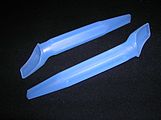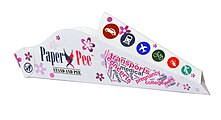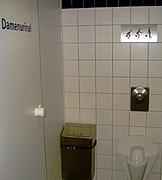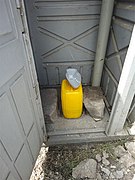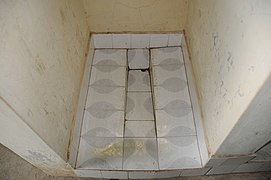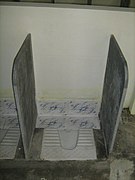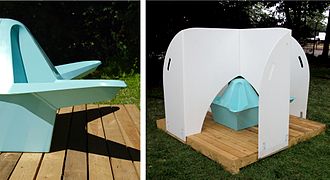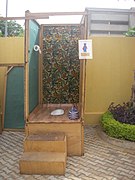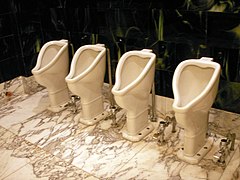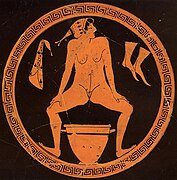
Urination is the release of urine from the bladder through the urethra to the outside of the body. It is the urinary system's form of excretion. It is also known medically as micturition, voiding, uresis, or, rarely, emiction, and known colloquially by various names including peeing, weeing, pissing, and euphemistically going number one. In healthy humans and other animals, the process of urination is under voluntary control. In infants, some elderly individuals, and those with neurological injury, urination may occur as a reflex. It is normal for adult humans to urinate up to seven times during the day.
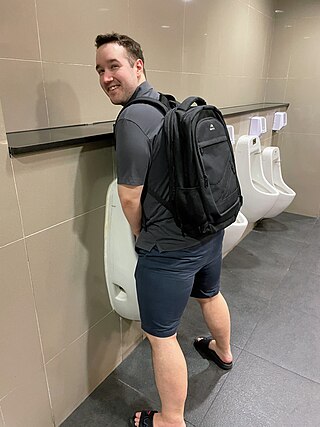
A urinal is a sanitary plumbing fixture for urination only. Urinals are often provided in public toilets for male users in Western countries. They are usually used in a standing position. Urinals can be with manual flushing, automatic flushing, or without flushing, as is the case for waterless urinals. They can be arranged as single sanitary fixtures or in a trough design without privacy walls. Urinals designed for females also exist but are rare. It is possible for females to use stand-up urinals using a female urination device.
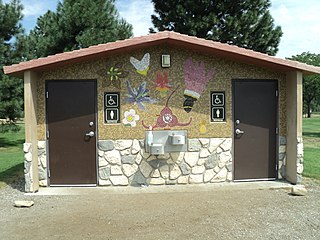
A public toilet, restroom, public bathroom or washroom is a room or small building with toilets and sinks for use by the general public. The facilities are available to customers, travelers, employees of a business, school pupils and prisoners and are commonly separated into male and female toilets, although some are unisex, especially for small or single-occupancy public toilets, public toilets are sometimes accessible to people with disabilities. Depending on the culture, there may be varying degrees of separation between males and females and different levels of privacy. Typically, the entire room, or a stall or cubicle containing a toilet, is lockable. Urinals, if present in a male toilet, are typically mounted on a wall with or without a divider between them. Local authorities or commercial businesses may provide public toilet facilities. Some are unattended while others are staffed by an attendant. In many cultures, it is customary to tip the attendant, especially if they provide a specific service, such as might be the case at upscale nightclubs or restaurants.

A chemical toilet collects human excreta in a holding tank and uses chemicals to minimize odors. They do not require a connection to a water supply and are used in a variety of situations. These toilets are usually, but not always, self-contained and movable. A chemical toilet is structured around a relatively small tank, which needs to be emptied frequently. It is not connected to a hole in the ground, nor to a septic tank, nor is it plumbed into a municipal system leading to a sewage treatment plant. When the tank is emptied, the contents are usually pumped into a sanitary sewer or directly to a treatment plant.
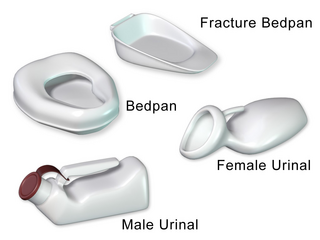
A bedpan or bed pan is a device used as a receptacle for the urine and/or feces of a person who is confined to a bed and therefore not able to use a toilet or chamber pot.

Potty parity is equal or equitable provision of public toilet facilities for females and males within a public space.
Sanistand was a female urinal manufactured by Japanese toilet maker giant TOTO from 1951 to 1971 and marketed by American Standard from 1950 to 1973. It appeared in a bathroom in the National Stadium for female athletes during the 1964 Summer Olympics in Tokyo. The urinal encouraged women to urinate from a standing position, without the need to sit on a shared seat.

Unisex public toilets are public toilets that are not separated by gender or sex.
A urine collection device or UCD is a device that allows the collection of urine for analysis or for purposes of simple elimination. UCDs of the latter type are sometimes called piddle packs.

A female urinal is a urinal designed for the female anatomy to allow for ease of use by women and girls. Different models enable urination in standing, semi-squatting, or squatting postures, but usually without direct bodily contact with the toilet. Sitting models also exist, and are designed for body contact with the urinal.
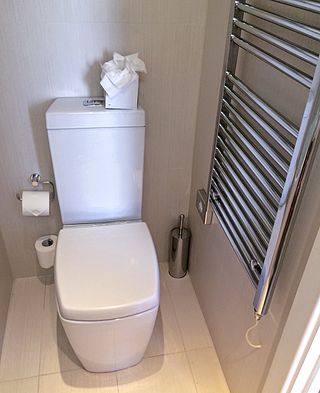
A toilet is a piece of sanitary hardware that collects human urine and feces, and sometimes toilet paper, usually for disposal. Flush toilets use water, while dry or non-flush toilets do not. They can be designed for a sitting position popular in Europe and North America with a toilet seat, with additional considerations for those with disabilities, or for a squatting posture more popular in Asia, known as a squat toilet. In urban areas, flush toilets are usually connected to a sewer system; in isolated areas, to a septic tank. The waste is known as blackwater and the combined effluent, including other sources, is sewage. Dry toilets are connected to a pit, removable container, composting chamber, or other storage and treatment device, including urine diversion with a urine-diverting toilet.
In health care, toileting is the act of assisting a dependent patient with their elimination needs.
Urine flow rate or urinary flow rate is the volumetric flow rate of urine during urination. It is a measure of the quantity of urine excreted in a specified period of time. It is measured with uroflowmetry, a type of flow measurement.

An interactive urinal is a device that allows users to play video games or control interactive displays while urinating. Several designs have been produced to date, usually comprising a urinal fitted with a pressure sensor to measure the strength and position of the urine flow and an LCD screen mounted above the urinal to provide animated graphics.

A pissoir is a French invention, common in Europe, that provides a urinal in public space with a lightweight structure. The availability of pissoirs aims to reduce urination onto buildings, sidewalks, or streets. They can be freestanding and without screening, with partial screening, or fully enclosed.

Pollee is a mobile female urinal, designed by Nuala Collins, Christian Pagh and Sara Nanna and produced by the Danish design bureau UIWE. It is specifically designed to be used at public events such as concerts or music festivals.
The Pee Pocket is a single-use urinary device that allows a person to stand while urinating, in situations where they could not normally do so.

The pee curl is a public urinal, many of which are found in the centre of Amsterdam. They originated at the end of the 19th century, and were first installed by the Public Works Department of Amsterdam.

madamePee is a mobile female urinal, without contact and without water supply. It is designed to be used at public events such as concerts or music festivals, but also in more durable situations such as construction sites, public gardens, etc.

A urine deflector is a device for deflecting the stream of urine during urination. These may be part of a chamber pot, latrine or toilet intended for the purpose, or they may be deterrents, installed in the sides or corners of buildings to discourage their casual use as urinals by passers-by. They may be constructed in various ways from a variety of materials but are typically designed to have an angled surface which catches and redirects the stream.

